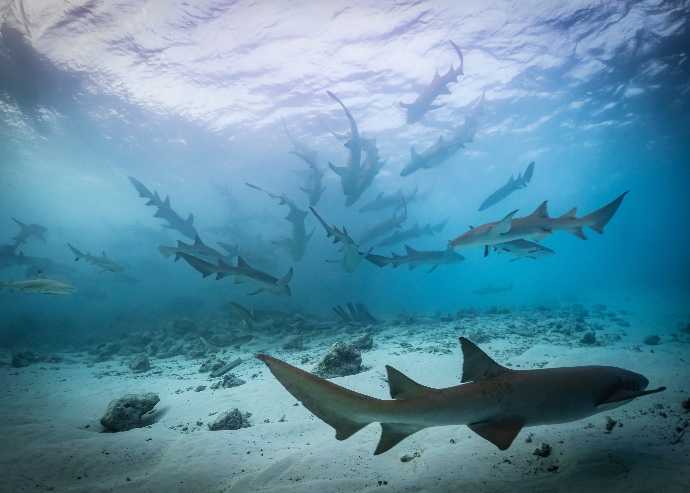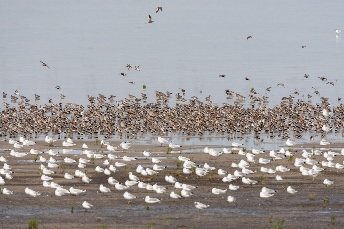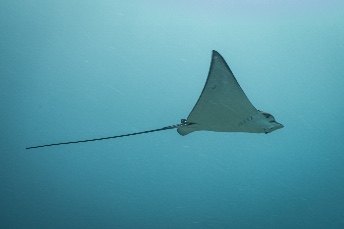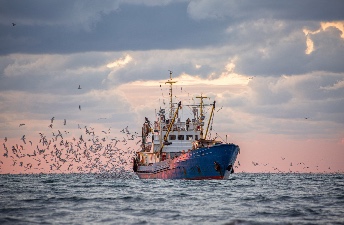Intertidal areas are of worldwide importance to sharks and rays

Intertidal areas are of greater worldwide importance to sharks and rays than previously thought. Researchers from the University of Groningen and the Royal Netherlands Institute for Sea Research (NIOZ) have discovered that intertidal areas—coastal areas with sand flats that fall dry at low tide—are important feeding grounds and hiding places for, for example, endangered species of shark and ray. Protection of these vulnerable and dynamic intertidal areas is, therefore, of great importance. The results from this study have been published in the scientific journal Fish and Fisheries on 21 February.

Biodiversity
Intertidal areas are dynamic areas that fall dry at low tide and flood at high tide. They are known for their ecological richness, including a high level of biodiversity and large numbers of animals. The rich benthic life in intertidal areas, such as shellfish, worms, crabs, and shrimps, attract enormous numbers of birds, which is something we see, for example, in our Wadden Sea. Birds use the intertidal areas to regain their strength during migration or to spend the winter. Birds that use the Dutch Wadden Sea spend the winter, for example, mainly on tropical intertidal flats along the West-African coast. Until now, the ecology of the intertidal areas worldwide has mainly been studied from the perspective of these birds. Less was known about the marine life. For the new study, biologists from the UG and NIOZ have analysed the scientific literature to identify the role of sharks and rays in intertidal areas. This shows that, in addition to birds, sharks and rays also have a significant role in these ecosystems.
Food and safety
The tidal cycle in intertidal areas presents a challenge for large marine animals such as sharks and rays. Principal researcher Guido Leurs: ‘In intertidal areas, we see mainly small species of shark and ray and, in addition, young individuals of larger species of shark, such as the hammerhead shark and bull shark. They use the shallow water to hide from larger predatory fish and to search for food.’ However, this is not without danger: sharks and rays that swim onto the intertidal flats at high tide may become stranded when the water recedes at low tide. Leurs: ’That is where small animals are at an advantage, it is easier for them to move along with the tides on and off the flats.’

According to the researchers, the ecological role of sharks and rays in intertidal areas is severely underestimated. ‘For example, we see rays doing a considerable amount of digging when searching for food, which may change the landscape of intertidal areas considerably,’ says Leurs. ‘These holes are likely to also affect other species that use these areas during low tide, such as birds.’ Furthermore, it is likely that birds, as well as rays and sharks, are partly hunting for the same food. Birds hunt for this prey during low tide and fish during high tide. Information about this has mainly been obtained from tropical intertidal areas, where there are still many species of shark and ray. These species have all but disappeared from our own Wadden Sea. It is not yet known what the impact of this is on these important areas.

Threats
Worldwide, a third of the approximately 1,200 shark and ray species are currently threatened with extinction1. However, this is half for species currently known to use intertidal areas, the researchers conclude. This is possibly due to overfishing of sharks and rays within these intertidal areas, but also outside these areas, where commercial fisheries are concentrated. Leurs: ‘Sharks and rays are mobile species that move between intertidal areas and the open ocean. This means that they are also vulnerable to overfishing when moving between these areas.’ The loss of sharks and rays from intertidal areas may upset the ecological balance because these predatory fish have an essential role. Moreover, 16 percent of the surface of intertidal areas has disappeared since 1984, according to a recent estimate2. Since sharks and rays are so important for intertidal areas and vice versa, the researchers advocate better protection of these ecosystems. To achieve this, collaboration with local communities and fishermen is crucial, because intertidal areas often also have a significant economic and cultural value.
Reference: Guido Leurs, Brian O. Nieuwenhuis, Thije J. Zuidewind, Nadia Hijner, Han Olff, Laura L. Govers: Where land meets sea: Intertidal areas as key-habitats for sharks and rays. Fish and Fisheries, 21 februari 2023
| Last modified: | 10 February 2025 09.09 a.m. |
More news
-
06 May 2025
Overcoming grid congestion: ‘Making better use of what we already have’
Grid congestion poses a major problem. There is little to no capacity to connect new households and businesses to the power grid and it risks halting the energy transition. Michele Cucuzzella, Associate Professor of Energy Systems & Nonlinear...
-
29 April 2025
Impact | Rubber recycling
In the coming weeks the nominees for the Ben Feringa Impact Award 2025 will introduce themselves and their impactful research or project. This week: Francesco Picchioni on his innovative way to recycle rubber.
-
29 April 2025
Impact | Improving Human-AI Decision-Making in healthcare
In the coming weeks the nominees for the Ben Feringa Impact Award 2025 will introduce themselves and their impactful research or project. This week: Andra Cristiana Minculescu on her research project on Human-AI Decision-Making in healthcare.

